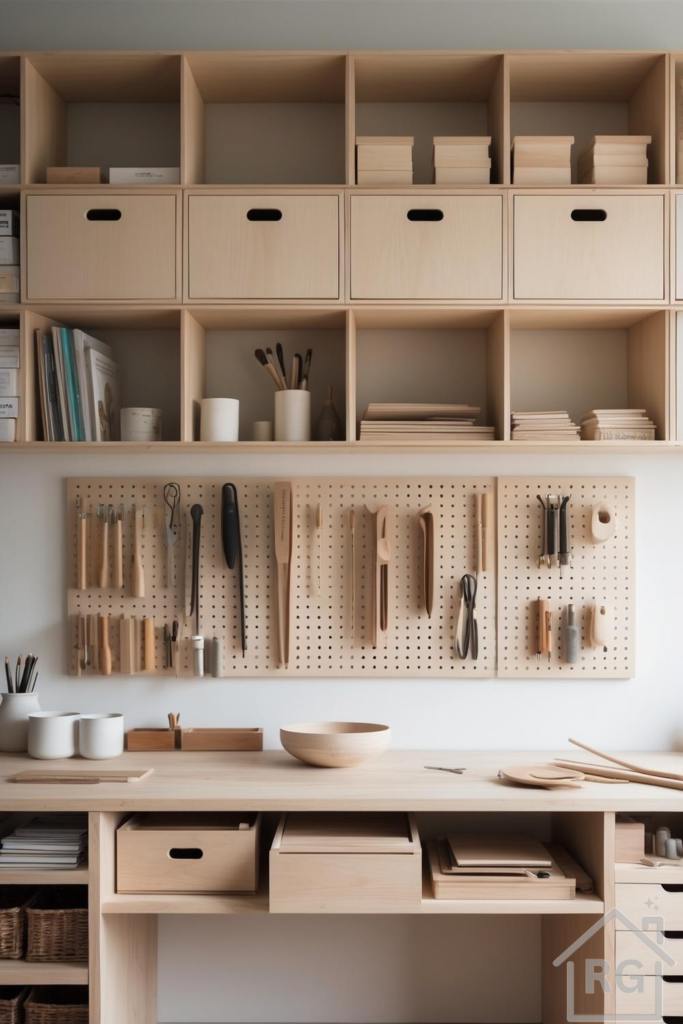
In the bustling rhythm of modern life, finding a sanctuary for creativity is more important than ever. Imagine a space where every tool has its place, where natural light floods in, and where the very atmosphere encourages focus and calm. This is the promise of a Japandi craft room — a harmonious blend of Japanese minimalism and Scandinavian warmth, designed to elevate your creative pursuits.
The image before us perfectly encapsulates this aesthetic: a meticulously organized workspace bathed in soft, natural light, showcasing the beauty of simplicity and functionality. It’s not just a room; it’s an invitation to create, to tinker, to dream.
The Essence of Japandi Design
Japandi is more than just a trend; it’s a philosophy that marries the rustic warmth of Scandinavian design (think hygge, comfort, and functionality) with the elegant simplicity and wabi-sabi principles of Japanese aesthetics (finding beauty in imperfection, natural materials, and clean lines). The result is a style that is both cozy and sophisticated, minimalist yet inviting. For a Japandi craft room, this means a space that is highly functional, decluttered, and visually soothing, allowing your mind to focus solely on the task at hand.
Key Characteristics of Japandi Design:
- Muted Color Palette: Creates a serene and calming atmosphere.
- Natural Materials: Emphasis on wood, ceramics, and organic textures.
- Clean Lines: Simple, uncluttered forms for a minimalist aesthetic.
- Appreciation for Craftsmanship: Valuing quality and handmade items.
- Purposeful Elements: Every item serves a function, minimizing excess.
This deliberate absence of excess contributes to an overall sense of tranquility and order, which is particularly beneficial in a craft room where tools and materials can easily become overwhelming without thoughtful organization.
Crafting Your Japandi Palette
The color scheme of a Japandi craft room is intentionally subdued, creating a backdrop that promotes serenity and allows your creative projects to take center stage. The dominant hues are derived directly from nature, fostering a calm and cohesive environment.
Key Colors for Your Japandi Craft Room:
- Warm, Light Wood Tones: Think fresh birch or pale maple. This natural wood forms the foundation of shelving, desks, and storage, radiating organic warmth and subtle grain variations.
- Crisp White: Used for walls and ceramic containers, providing a bright, airy contrast and enhancing spaciousness. For example, a pristine white wall behind a pegboard makes wooden tools pop.
- Subtle Greige or Soft Grey: Light, almost imperceptible hints can add depth in the background or shadows without distracting.
- Muted Charcoal or Deep Brown: Darker elements like tool handles can ground the palette, avoiding harsh contrasts and maintaining a cohesive look.
This careful selection of colors ensures visual clutter is minimized, and the focus remains on the tactile experience of crafting.
Embracing Natural Textures and Materials
Texture plays a crucial role in Japandi design, adding richness and depth to a minimalist space without relying on excessive ornamentation. In a Japandi craft room, the materials themselves become the decor, celebrated for their inherent beauty and tactile qualities.
Essential Materials for a Japandi Craft Room:
- Wood: The most prominent material, from light-toned plywood shelving to solid workbenches. Wood brings warmth, durability, and a connection to nature. Embrace subtle variations in grain and tone, as these imperfections add character. A light wood pegboard, for instance, is both functional storage and a textural focal point.
- Ceramics: Matte ceramic vessels in clean white or off-white offer a smooth, cool contrast to wood, perfect for holding brushes and tools.
- Metal: The glint of metal from tool parts adds a touch of industrial functionality.
- Woven Textures: Baskets introduce soft, organic texture, ideal for concealing bulkier items.
- Paper and Books: Even stacks of paper and books contribute a subtle textural element, hinting at the creative processes within the space.
This thoughtful layering of natural textures creates a sensory-rich environment that is both visually appealing and pleasant to touch.
Smart Storage: The Heart of a Functional Craft Room
Organization is paramount in any craft room, and the Japandi aesthetic excels at creating highly functional, yet aesthetically pleasing, storage solutions. The goal is to keep your workspace tidy and efficient, allowing for seamless transitions between projects and minimizing distractions.
Effective Storage Solutions:
- Integrated Shelving Units: Combine open cubbies for displaying books or larger tools with closed drawers for discreet storage. This dual approach maintains clean lines while maximizing utility.
- Light Wood Pegboard: A versatile system for hanging tools of various shapes and sizes neatly and accessibly. It frees up valuable desk space and turns functional tools into an artistic display.
- Under-Workbench Storage: Utilize wooden storage boxes, drawers, and woven baskets for organizing materials, fabrics, or works-in-progress.
The key is a place for everything, and everything in its place, ensuring a smooth and enjoyable crafting experience in your Japandi craft room.
Furniture & Layout for Flow and Focus
The layout and choice of furniture in a Japandi craft room are designed to optimize workflow and promote a sense of calm focus. Every piece serves a purpose, contributing to the overall efficiency and aesthetic harmony of the space.
Key Furniture and Layout Principles:
- Spacious Workbench: A generous surface area provides ample room for spreading out materials and working on projects. Choose one made from light, smooth wood for cohesion. Integrated drawers and open shelving enhance functionality.
- Vertical Storage Integration: Position shelving units directly above the desk to keep frequently used items and reference materials accessible. This minimizes unnecessary movement and maximizes productivity.
- Clean Lines: Furniture devoid of ornate details contributes to the minimalist aesthetic, preventing visual noise and allowing the eye to rest.
- Optimized Workflow: Ensure clear access to the workbench and position the pegboard at eye level for easy tool retrieval. Every element should be placed with intention to support the creative process.
- Good Lighting: Crucial for visibility and reducing eye strain. Prioritize natural light, supplemented by task lighting where needed.
Curating Your Tools and Decor
In a Japandi craft room, even the most utilitarian objects can become elements of beauty. The philosophy encourages a mindful approach, valuing quality over quantity and finding aesthetic appeal in functional items.
Mindful Curation Tips:
- Tools as Art: Neatly arrange crafting tools on the pegboard. Their varying shapes, sizes, and materials create a dynamic visual rhythm, celebrating the craft itself.
- Minimal & Purposeful Decor:
- Use simple wooden bowls as practical containers and sculptural elements.
- Opt for white ceramic holders for brushes and pencils to reinforce the serene aesthetic.
- Allow neatly organized stacks of books and wooden boxes to contribute to overall order and visual appeal.
Avoid superfluous knick-knacks; every item should be essential for the craft or contribute to the calm, inspiring atmosphere. This curated approach ensures the room feels uncluttered and focused, a true sanctuary for creative endeavors.
Bringing It All Together: A Sanctuary for Creativity
The beauty of a Japandi craft room lies in its ability to foster a sense of calm and focus, transforming a potentially chaotic workspace into a haven of productivity and inspiration. By embracing the core principles of this design aesthetic — natural materials, a muted color palette, clean lines, and intelligent storage — you create an environment that supports your creative journey.
Imagine the quiet satisfaction of reaching for a tool from its designated spot on the pegboard, the smooth feel of the light wood workbench beneath your hands, and the gentle light illuminating your project. This room isn’t just about aesthetics; it’s about enhancing your well-being and making the act of creation a more joyful and seamless experience. It’s a space where the mind can clear, ideas can flow freely, and craftsmanship is celebrated.
Steps to Create Your Japandi Craft Room:
- Declutter: Start by removing anything that doesn’t serve a purpose or bring joy.
- Invest in Quality Natural Materials: Prioritize wood, ceramics, and other organic textures for furniture and decor.
- Think Intentionally: Consider how each element contributes to the overall sense of peace, efficiency, and inspiration.
Whether you’re a painter, a sculptor, a textile artist, or a hobbyist, a Japandi-inspired craft room provides the ideal backdrop for your passion. It encourages a mindful approach to your work, promoting organization and reducing stress. Your dream craft space, a true sanctuary for creativity, awaits.
